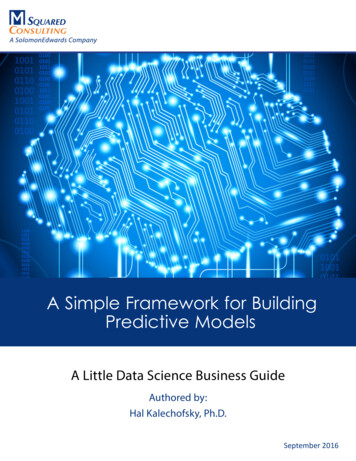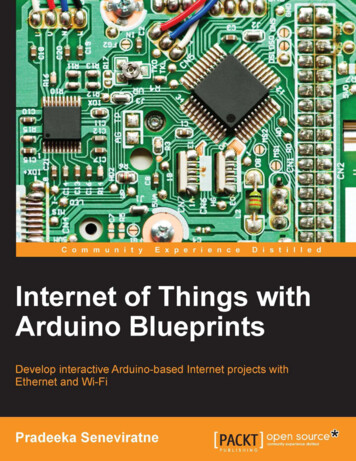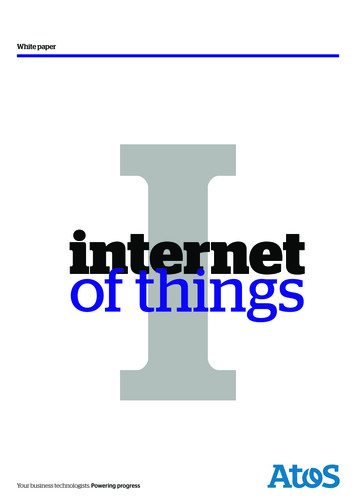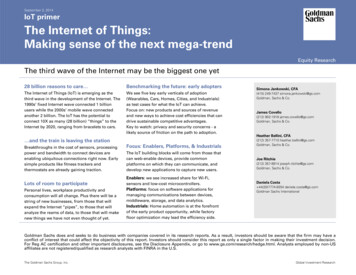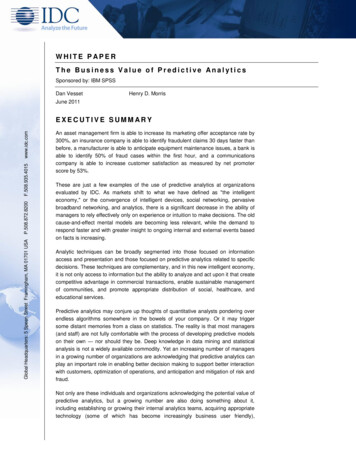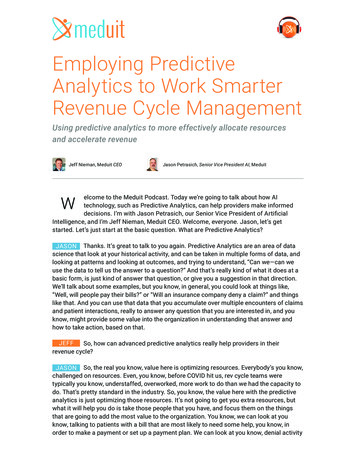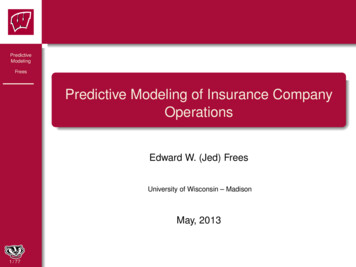
Transcription
BUE ACE1Sustainable Vital Technologies inEngineering & Informatics8-10 Nov 2016Internet of Things – A Predictive Maintenance Tool for GeneralMachinery, Petrochemicals and Water TreatmentAbdel Bayoumia, Rhea McCaslina*aUniversity of South Carolina, Columbia 29208, USAAbstractImproper and unnecessary maintenance actions can result in a waste of resources, time, and money. Training andeducation play an important role in the successful implementation of a maintenance strategy. The Center for PredictiveMaintenance (CPM) at the University of South Carolina has developed a demonstration methodology and tool that can beused to educate and train users extending from maintainers to leadership on the maintenance process from fault tomaintenance action. This overall methodology has been developed so that it can be applied to a variety of industriesincluding general machinery, petroleum and petro chemicals, and water treatment. All of these industries have a need forsuccessful implementation of predictive maintenance programs and this demonstration methodology can be used to trainand educate users. This demonstration tool will walk an audience through the maintenance process starting with thecollection of sensor and historical data. Then it will show the analysis of the data through modeling and statistical analysistechniques. Finally, the data and results are displayed in unique dashboards that provide personnel with the informationneeded to make educated decisions on the condition and maintenance of their system. 2012 Published by Elsevier Ltd. Selection and/or peer-review under responsibility of GlobalScience and Technology Forum Pte LtdKeywords: Predictive maintenance, Internet of Things;1. IntroductionTraditionally, the two most common strategies for maintenance management were either reactive orpreventive. Reactive maintenance is a failure-based strategy where maintenance actions are performed onlyafter the component has failed. Preventive maintenance is a time-based or usage-based strategy wheremaintenance actions are performed after a set amount of time. Both types of strategies have their strengthsand weaknesses. Reactive maintenance can save money in the short-term, but long-term can lead to higher* Corresponding author. Tel.: 1-803-777-1845; fax: 1-803-777-0106.E-mail address: bayoumi@sc.edu
2Abdel Bayoumi/ BUE ACE1 SVT2016 repair costs and longer down-times. Preventive maintenance results in higher reliability but can be morecostly if maintenance is performed before it is actually needed.In order to achieve both high reliability and low cost, a predictive maintenance strategy would need to beimplemented. Predictive maintenance is condition-based and maintenance is performed only when thecomponent requires it. Predictive maintenance also allows for predictions to be made on when a componentwill fail which allows maintainers to be prepared for that failure before it happens. Implementing predictivemaintenance can provide a company with an optimal maintenance strategy at a low cost with the highestreliability.2. BackgroundMaintenance is a large part of any industry and depending on the industry can represent between 15 and 60percent of total costs. In the United States, industries spend more than 200 billion each year on maintenance.Recent surveys have shown that there is a need for better maintenance implementation. Improper andunnecessary maintenance actions make up almost 33% of maintenance costs [Mobley, 2002].A successful implementation of predictive maintenance can result in many benefits including reducedmaintenance costs, increased readiness and availability, and increased feelings of safety. In order to achievethese benefits, predictive maintenance requires new processes and technologies. This is where training andeducation become important in the success of a predictive maintenance strategy. If maintainers and otherusers are not properly trained on the different processes of predictive maintenance then the results of costsavings and high reliability will not be seen.The Center for Predictive Maintenance has developed an Internet of Things (IoT) based methodology forcreating a demonstration that can be used to train and educate users on predictive maintenance. Thismethodology can be applied to various industries such as general machinery, petroleum and petro chemicals,and water treatment. Even though these industries involve differing maintenance needs and procedures, thesame IoT methodology for predictive maintenance can be applied.3. Internet of ThingsThe Internet of Things (IoT) refers to a network of interconnected objects or things [Atzori et al, 2010].These objects are able to communicate and interact with each other regardless of physical location. In themaintenance world, these objects are embedded with sensors that monitor the condition of the object. Overthe years, the IoT has increased in popularity in maintenance. It provides a framework for users to connectand collect data from all the components and systems that they are monitoring. This data is collected andanalyzed in real time to identify and extract meaningful relationships in the data. The collected data can alsobe compared to previous trends that were calculated with historical data. In the IoT framework, not only arethe physical components and systems connected, but also every user in the maintenance process is connected.This means that a user does not need to be physically with the asset to know its condition. The information auser would need is presented to them with real-time dashboards and alerts.The IoT has changed the way users think about data. If an IoT framework is being implemented, thenthere is a large amount of data is continuously being collected in real-time from the network of sensors. Thisdata being collected from the components and systems is full of valuable insights and useful relationships butit also presents some difficulties. One problem is how to manage and extract value from the IoT data.Previously, data could be stored locally but this approach has its limits on storage and efficiency. In order toquickly store, manage, and analyze IoT data, cloud computing will need to be used.Cloud computing uses a network of servers hosted on the internet to store, manage, and analyze data asopposed to doing it locally on one machine. This setup allows resources such as computing power and
Abdel Bayoumi/ BUE ACE1 SVT2016storage to be shared across the network of servers providing a large capacity for storage and processingpower. The cloud framework can be divided into different areas that include cloud storage, cloudapplications, and cloud infrastructure as shown in Figure 1. The cloud storage contains databases for thecollected and processed data. Cloud applications include programs that a user might need access to. Thisincludes programs for analyzing the data, creating diagnostic and prognostic models, generating reports andwork-orders, and real-time dashboards containing information. The cloud infrastructure refers to the setup ofthe network. Having the data and programs stored in the cloud allows a user with the proper credentialsaccess no matter where they are located. There is also the benefit that they can view the results and data fromany device because the programs are not located locally on their machine but instead in the cloud.Cloud computing addresses the problem of storing and managing the IoT data but it doesn’t solve theproblem of how to analyze the data. This is where the research area of big data analytic fits in. Big data is aterm used to describe large amounts of data sets that can be analyzed for extracting patterns, trends, andrelationships. There are large amounts of data associated and generated from maintenance. Data directlyrelated to the condition of a component or system can be historical or current (real-time). Historical dataincludes logistical data from maintenance records which can also include a user’s experience and knowledge.Historical data also includes previously collected sensor data. Current data includes the data being collectedfrom the sensors. Other types of data that might impact the condition of a component or system can also becollected such as the weather or environmental variables. Data and knowledge from technical manuals andreports also have value. In order to extract useful information from all this data, advanced analytic techniquesfor big data will need to be used.Figure 1: Internet of Things cloud framework.3
4Abdel Bayoumi/ BUE ACE1 SVT2016 Figure 2: Internet of Things demonstration methodology4. MethodologyPredictive maintenance is a system’s level approach that can be broken down into four areas: datacollection and integration, model and predict, optimize and act, and present. The developed methodologycreates a demonstration that addresses those four areas. Figure 2 shows the demonstration methodology. Thegoal of the demonstration is to allow a user to see the whole process from start to finish.4.1 Data Collection and IntegrationData collection is a very important step in predictive maintenance and data can come in three differenttypes: logistical, sensing, and testing. Logistical data contains information on the maintenance actionsperformed on a component or system. Sensing data is collected from sensors on the component or system.The last type of data is testing data, this is collected sensor data from a test stand that can be used to validateand refine models and relationships found in the logistical and sensing data. After collection, the data willneed to be processed before it can be stored or analysed. Written text from logistical data can often containmistakes and gaps due to human error. Techniques such as natural language processing will need to be donein order to transform the text into a useable form [Bokinsky et al., 2013]. The collected sensor data will be
Abdel Bayoumi/ BUE ACE1 SVT2016processed using techniques such as advanced signal processing. Advanced signal processing helps in theextraction of relationships between sensors [Coats et al., 2011].Data integration will then be done to combine the different types of data into one set. Combined, the datacan give a more complete picture than one set could on their own.4.2 Model and PredictAfter the data has been collected and processed, it can be analysed through models and predictions. Datacan be used to address many different questions depending on what the user’s goals are and what predictionsthey want to make. For example, if the user is interested in information about the life of the component orsystem they are monitoring then diagnostic and prognostic models can be created to show information such asremaining useful life. In order to create diagnostic and prognostic models, historical data would be used tocreate an initial model for detecting failures. The current real-time data would compared against those modelsto see if a failure exists. The current data is also stored and later used to refine the initial fault models. Otherpredictions can include models for cost-benefit analysis, failure points and failure modes, and design andmanufacturing.4.3 Optimize and ActThe next step involves asset management. After the data has been used to create models and predictions,the results of these models will need to be interpreted. This step results in the creation of reports, generationof work-orders, and recommendation of maintenance actions. The types of users that would be using theseresults for decision-making include leadership, operators, maintainers, and engineers.4.4 PresentThe final step is to present the data and results in the form of a dashboard. These dashboards are created tobe tailored to fit the needs of the user so that they only view the information important to them. Thesedashboards allow a user to view data in real-time, look at current trends, and monitor the health of a system.5. Applications to IndustryThe IoT methodology can be used to develop predictive maintenance tools for the advancement ofpredictive maintenance in industries such as general machinery, petroleum and petro chemicals, and watertreatment. Even though these industries involve differing maintenance needs, the same IoT methodology forpredictive maintenance can be applied to all of them. It is important to advance the maintenance practices ofthese industries because they play a vital role in our lives. In the area of general machinery, components haveusually been repaired on a time-based schedule which leads to unnecessary maintenance repairs and increasein maintenance costs. The petro chemicals industry is facing large growth and with that a need for efficientmaintenance practices. One important area of the water resource industry is the desalinization of water. Inorder to keep the cost of desalinization down, unscheduled maintenance needs to decrease. Predictivemaintenance can address all of these problems and lead to a reduction in unscheduled and unnecessarymaintenance.5
6Abdel Bayoumi/ BUE ACE1 SVT2016 Figure 3: Internet of Things demonstration setup for various industries using different components.5.1 General MachineryIndustries related to general machinery include aviation, aerospace, steel industries, paper industries, andother heavy industries. These industries have a lot of maintenance issues related to gears, bearings, shafts,and structure. Previously, these industries have relied on a preventive maintenance strategy based on time.Due to this, maintenance is one of the largest cost drives in these industries with maintenance representing upto 60% of total costs [Mobley, 2002]. Implementing predictive maintenance would help to reduce these costsby decreasing the amount of unnecessary repairs. A demonstration for predictive maintenance in generalmachinery has been created using a gearbox, shown in Figure 3 [Edwards et al., 2016]. Rotating componentsare heavily used in general machinery, and a gearbox is a good example.5.2 Petroleum and Petro ChemicalsIndustries related to this area include energy, gas, oil, and nuclear. The products of this industry providemany of the needed materials for our daily lives from propane to nuclear energy. This area is alsoexperiencing a large growth and with that an increase in maintenance needs. Implementing predictivemaintenance can help to address the maintenance issues this industry will face while reducing cost. Twoproblematic areas in this industry are control valves and process automation. A demonstration related to thisindustry could be built around a control valve, shown in Figure 3. The control valve would be fitted withvarious types of sensors. The goal of this demonstration would be to train and educate users on new
Abdel Bayoumi/ BUE ACE1 SVT2016monitoring techniques and how they could benefit their company. Similar to the demonstration for generalmachinery, there will be three screens for the user to view during the demonstration. The user will be able tosee on the screens how different monitoring techniques can improve the data collected and provide moreaccurate models.5.3 Water TreatmentThe desalination and purification of water is becoming a more pressing issue as the human populationincreases and water resources decrease. Water desalination has the potential to be a solution to water shortageproblems, but currently it is a very expensive process. Establishing a predictive maintenance program canhelp to reduce some of these costs by reducing unnecessary downtimes and increasing reliability andavailability. For this demonstration, a pump will be used to demonstrate predictive maintenance, shown inFigure 3. Sensors will be used to monitor pressure, temperature, and motor amperage. The goal of thisdemonstration will be to show how predictive maintenance can ensure that unscheduled maintenance is not apart of the high cost of water desalination. This demonstration would be similar to the setup of the generalmachinery demonstration.5.4 ResultsThe gearbox demonstration for general machinery has already been implemented by the Center forPredictive Maintenance. Demonstrations for other industries would be very similar with just the componentbeing monitored changing. The gearbox is fitted with various sensors to collect data for temperature andvibration. Data collection software would then be used to transfer the sensor data to be stored in a databasewhere historical data has already been processed. During the demonstration, users will see three screens. Thefirst represents the “data collection and integration” step. The users will see how the data looks coming offthe gearbox and visualize any trends. The “model and predict” step is not visible to users by itself becauseit’s mostly calculations, but the user can get an understanding of this step by observing what happens beforeand after this step. The “model and predict” step will take in the data being collected and run it againstcreated fault models. The output of this step will be visible in the next screen which shows the output of themodels. The second screen represents the “optimize and act” step and will display work-order generationbased on the results from the predictive models. The last screen represents the “present” step and displays adashboard that shows the real-time condition of the gearbox. The demonstration is designed to allow faults tobe introduced.Figure 4 shows example screenshots of what the audience sees during the demonstration. The top rowrepresents views during normal operating conditions. In screen one the audience can see the values fordifferent sensor readings. During normal operating conditions nothing unusual is noted. The data iscontinuously being compared against the fault models and outputs the results to screen two. Since there is nofault being detected, the bottom portion of the work order is empty. Screen three represents a real-timedashboard that shows the user the health condition of the gearbox. The health condition reads normal sincethere is no fault. The bottom row represents what an audience sees when there is a fault detected. During thedemonstration, a fault will be introduced. In this example it is a thermal fault. In screen one, the audiencewill see the temperature readings start to rise compared to when the gearbox was running normally. The faultmodels will now detect that there is a thermal fault based off of the new data. Screen two will then create awork order based on a thermal fault and the bottom section will be filled out with instructions. Screen threewill also be updated and the dashboard will show the health condition as being critical, alerting the user that7
8Abdel Bayoumi/ BUE ACE1 SVT2016 something is wrong. This setup allows the audience to watch all three screens change as the condition of thecomponent changes.Figure 4: Screenshots of what the audience sees during the demonstration.6. ConclusionsWith the advancement of technologies such as big data analytics and cloud computing, IoT has continued togrow and change the way users collect, view, and analyse data. Using an IoT approach in maintenance canhelp industries move to predictive maintenance which is the optimal maintenance strategy. Predictivemaintenance relies heavily on data, and IoT provides the best methodology for analysing data and connectingall users. The demonstrations previously outlined are built on an IoT methodology for predictive maintenancethat can be applied to any industry’s maintenance needs.ReferencesMobley, R. Keith, 2002. An Introduction to Predictive Maintenance. Second Edition, Elsevier, 2002.Atzori, Luigi, Antonio Iera, Gaicomo Morabito. “The Internet of Things: A survey.” Computer Networks, vol. 54, no. 15, pp. 2787-2805,October 2010.Bokinsky, Huston, Amber McKenzie, Abdel Bayoumi, Rhea McCaslin, Andrew Patterson, Manton Matthews, Joseph Schmidley, andMajor General Lester Eisner. “Application of Natural Language Processing Techniques to Marine V-22 Maintenance Data forPopulating a CBM-Oriented Database.” AHS Airworthiness, CBM, and HUMS Specialists' Meeting, Huntsville, AL, 2013.Coats, David, Kwangik Cho, Yong-June Shin, Nicholas Goodman, Vytautas Blechertas, and Abdel-Moez E. Bayoumi. "Advanced TimeFrequency Mutual Information Measures for Condition-Based Maintenance of Helicopter Drivetrains." IEEE Transactions onInstrumentation and Measurement, vol. 60, no. 8, pp. 2984 - 2994, August 2011.Edwards, Travis, Rhea McCaslin, Edward Bell, Abdel E. Bayoumi, and Lester Eisner. “A Training and Educational Demonstration forImproving Maintenance Practices.” AHS 72nd Annual Forum, West Palm Beach, Florida, 2016.
The Center for Predictive Maintenance has developed an Internet of Things (IoT) based methodology for creating a demonstration that can be used to train and educate users on predictive maintenance. This methodology can be applied to various industries such as general machinery, petroleum and petro chemicals, and water treatment.
